PUZZLE TECHNIQUES
HOW TO DO FUTOSHIKI
- Look for column and row exclusions.
- Check for a chain of ascending or descending symbols.
- Do you see forced minimum and maximum digits?
- Narrow down possible cells for minimum and maximum values.
- Combine techniques to narrow down the candidates for a cell.
- Look for a chain of 2 ascending or 2 descending symbols.
- The technique of AB elimination.
- Two opposite symbols influecing a cell in the same row or column.
HOW TO BEAT FUTOSHIKI
Start with small futoshiki puzzles and always use logic to make your decisions. When you understand our solving tips and tricks, then it is time to practice our futoshiki online puzzles. The puzzles on our website are 5x5.
In the following tutorial we will explain basic and advanced solving techniques. We will solve futoshiki puzzles step by step with clear illustrations.
If you have trouble remembering which symbol represents greater than and which less than, think that the symbol is a mouth that wants to eat the largest number.
COLUMN AND ROW EXCLUSIONS
Each cell is part of a column AND a row. So in a Futoshiki 5x5 each cell has 8 neighbors. There are always 4 row neighbors and 4 column neighbors. If there is an empty cell and all the digits, except one, are taken by its neighbors, then that cell must contain the missing digit.
In the example below, the cell at r1c2 is empty. In column 2 are the digits 125 and in row 1 we have digits 14.
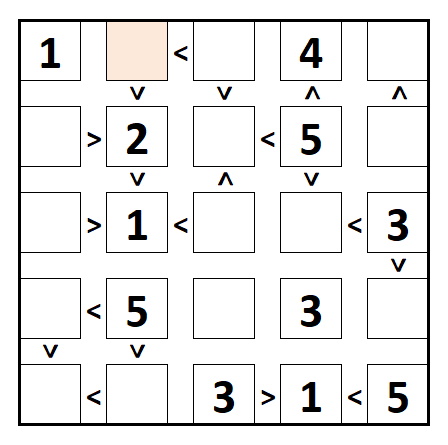
Conclusion: digit 3 is the only possibility for r1k2.
CHAIN OF ASCENDING OR DESCENDING SYMBOLS
If you find a chain of either < (all ascending) or > (all descending) symbols and the chain is long enough, then you can strongly limit the number of candidates of a cell at the start or the end of the chain. Sometimes only one candidate remains.
In the example below, we have a start of a chain at r4c2. The descending chain end at r5c5.
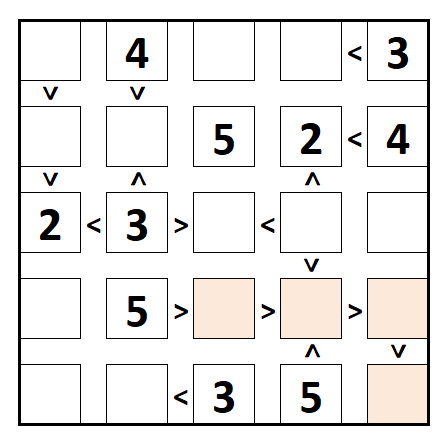
Conclusion: digit 4 must be r4c3, digit 3 in r4c4, digit 2 in r4c5 and finally digit 1 in r5c5.
FORCED MINIMUM AND MAXIMUM DIGITS
If you are lucky then you can find a cell that is forced to have the minimum or the maximum digit. In a futoshiki 5x5 digit 1 is the minimum and digit 5 is the maximum.
In the example below, we have digit 2 in r1c4 and the digit in r1c5 must be smaller. We also have digit 4 in r5c4 and the digit in r5c5 must be bigger.
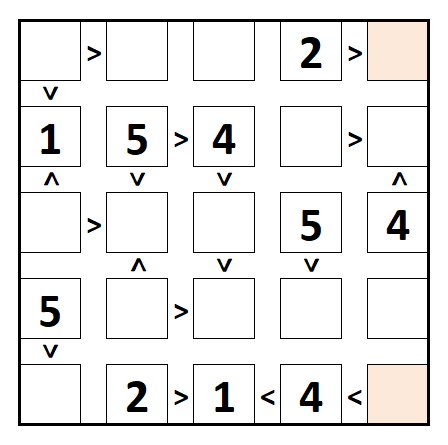
Conclusion: you must put digit 1 in r1c5 and digit 5 in r5c5.
EXCLUSION OF MINIMUM AND MAXIMUM VALUES
Cells that must be greater than other cells must have a digit higher than 1. Of course cells that must be lower than other cells cannot countain the highest digit. Check if the lowest or highest digit is already on the grid in one or more cells
In the example below, we have digit 5 in r4c1 and in r5c2. We now mark the cells that can contain digit 5 based on the digits that are already on the grid. This is step 1.
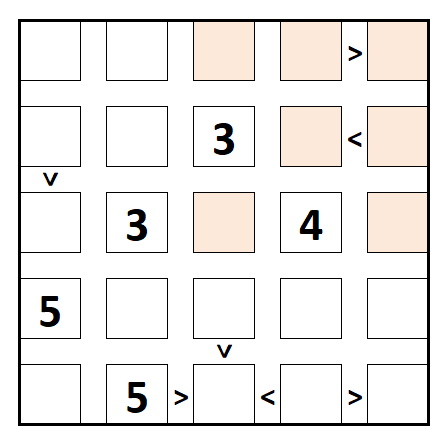
Conclusion: there are 7 cells left and still 3 digits 5 to place on the grid.
Time for step 2. Look at the symbols > and < between the cells that we have marked. Try to exclude more cells.
In the example below:
- Digit 5 can't be in r1c5 because this cell must contain a digit that is higher than the digit in r1c4.
- Digit 5 can't be in r2c4 because this cell must contain a digit that is smaller than the digit in r2c5.
There now are 5 cells left to place 3 digits 5.
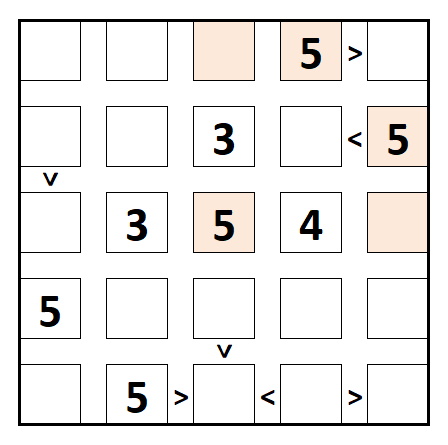
Conclusion: When we look at column 4, then digit 5 must go in r1c4. So in column 3 digit 5 can only go in r3c3 and finally the last digit 5 must go to r2c5.
CHAIN OF 2 ASCENDING OR 2 DESCENDING SYMBOLS
With a difficult puzzle we are already satisfied with a chain of 2 ascending or descending) symbols. We try to use this information the exclude digits from some cells and of course to find the correct digit of another cell.
In the example below, we find a descending chain in cells r1c4, r1c5 and r2c5.
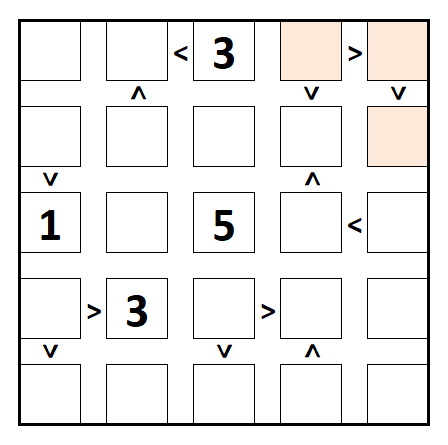
Conclusion: digit 1 cannot be in r1c4 or r1c5, because then we would have an impossibility in r2c5. So digit 1 in row 1 must go to r1c2.
AB ELIMINATION
What does this techniques mean? If you have a row or column with 2 cells that only have 2 candidates (=AB), then you can remove AB as candidates from the other cells in that row or column.
In the example below, we find a descending chain in row 1 and in row 5 when we focus on column 3. As a result 35 (=AB) or the only candidates for r1c3 and r5c3.
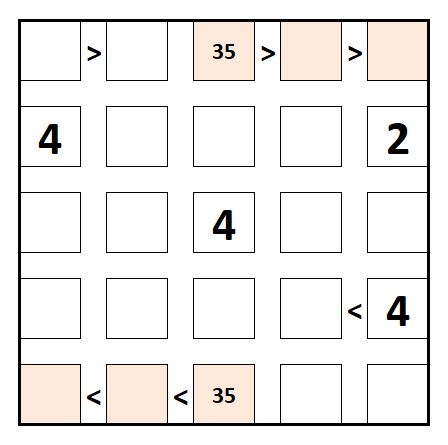
Conclusion: we can now remove 35 (=AB) as candidates from r2c3 and r4c3.
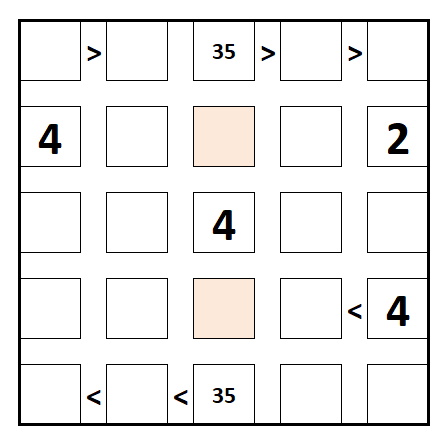
Conclusion: we can now place digit 1 in r2c3 and digit 2 in r4c3.
2 OPPOSITE SYMBOLS INFLUENCING A CELL
It is a long definition, but the technique is rather simple and clear. For this technique to work the 2 opposite symbols must be in the same row or column.
In the example below, we find r2c5 influencd by 2 opposite symbols. So r2c5 must be higher than at least two digits. So it must be 3 or higher.
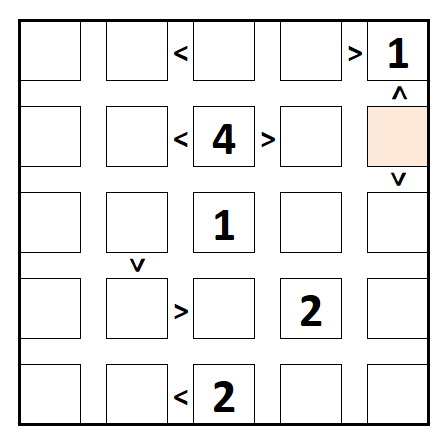
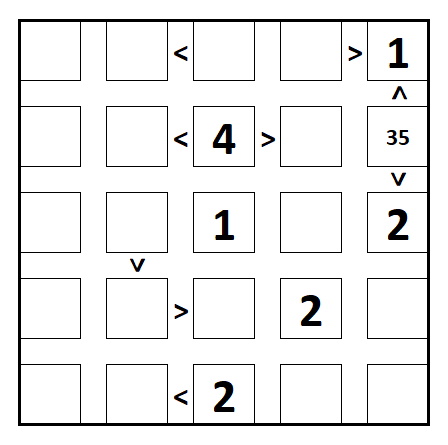
Conclusion: digit 2 in column 5 must go to r3c5.


